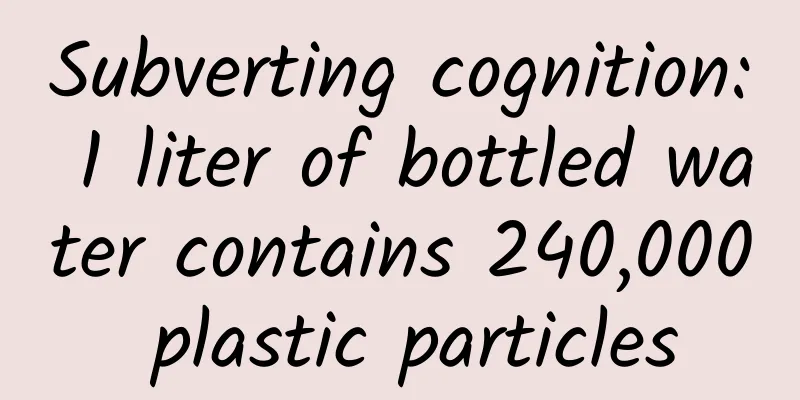Subverting cognition: 1 liter of bottled water contains 240,000 plastic particles

|
Studies have confirmed that microplastics that are harmful to the human body are everywhere, from disposable paper cups and plastic bottles to human breast milk and human placenta, to the Arctic and Mount Everest. However, a recent study shows that compared with the actual situation, the number of tiny plastic particles that humans have been able to observe in the past is negligible - based on new optical imaging technology, scientists can observe nanoplastics faster and better, increasing the number of "visible" plastic particles by 10-100 times . In this study, scientists tested three popular bottled water brands on the US market (the specific brands were not disclosed), and the quantitative results showed that each liter of bottled water contained more than 100,000 plastic particles, most of which were nanoplastics. Image: Hundreds of thousands of previously invisible tiny plastic particles in bottled water. The related research paper, titled “Rapid single-particle chemical imaging of nanoplastics by SRS microscopy,” has been published in the scientific journal Proceedings of the National Academy of Sciences. Previously, due to the lack of effective analytical techniques, basic knowledge on nanoplastics remained blank. This research is expected to fill the knowledge gap on nanoscale plastic pollution. It has become a public issue Global plastic production is close to 400 million tons per year, more than 30 million tons are dumped into waters or on land each year, and many products containing plastic, including synthetic textiles, also shed particles during use. Unlike natural organic matter, most plastics do not break down into relatively harmless substances; they simply keep breaking apart into smaller and smaller particles of the same chemical composition, with no theoretical limit to how large they can get beyond a single molecule. Microplastics are defined as plastic fragments ranging from 5 mm to 1 micron, which are produced when plastic is broken down into smaller and smaller pieces. When these particles are ingested by humans and other organisms, they may have unknown effects on health and ecosystems . Previous studies have confirmed that each bottle of water contains thousands of identifiable microplastic fragments. Plastic in bottled water became a public issue largely because scientists detected an average of 325 particles per liter of water in a 2018 study; subsequent studies have doubled that number. Scientists suspect the actual number is far greater than what they observed, but there has been no research on microplastics smaller than 1 micron in size. Now, a research team led by Columbia University has used improved new technology to allow people to truly see the products of further decomposition of microplastics - nanoplastics (less than 1 micron in size) . Unlike microplastics, nanoplastics are much smaller and can pass directly through the intestines and lungs into the bloodstream, where they can be transported to organs such as the heart and brain. They can also invade cells and even pass through the placenta into the bodies of unborn babies. Scientists are eager to understand the possible effects of these particles on various biological systems through a series of studies. "People have developed methods to look at nanoparticles, but they don't know what they're looking at," said Naixin Qian, a graduate student in Columbia's Department of Chemistry and the paper's first author. She said previous studies could provide an overall estimate of nanomass, but most couldn't count individual particles or identify which were plastics and which were something else . "Before, this was uncharted territory, and toxicity studies were just guesses about what was in it," said co-corresponding author Beizhan Yan, an environmental chemist at Columbia University's Lamont-Doherty Earth Observatory. "This study opens a window for us to peek into a world that was previously inaccessible." Maybe it's more than just these In this work, the researchers identified and counted nanoplastic particles in bottled water for the first time. They found that, on average, bottled water contained about 240,000 detectable plastic fragments per liter—a number 10-100 times higher than previous estimates based on larger sizes. The discovery was made possible by a new method called stimulated Raman scattering microscopy , which uses two lasers fired simultaneously to probe a sample, causing specific molecules to resonate. The method was invented by co-corresponding author Wei Min, a biophysicist at Columbia University. Figure | Detection of micro-nanoplastics in bottled water: sample preparation, SRS imaging and data analysis. In addition, for seven common plastics, the researchers created a data-driven algorithm to interpret the experimental results. They tested three popular bottled water brands on the US market and analyzed plastic particles with a diameter of only 100 nanometers. They found between 110,000 and 370,000 plastic particles per liter of bottled water, 90 percent of which were nanoplastics and the rest microplastics . They also identified which of seven specific types of plastic the particles were and mapped their shapes, which is valuable for biomedical research. Figure | Statistical analysis of particle size and shape of each plastic polymer in bottled water. One common plastic is polyethylene terephthalate (PET) , which is the material used to make most water bottles. When water bottles are squeezed or heated, PET can break off and enter the water as particles. A recent study showed that when water bottle caps are repeatedly opened and closed, many particles can also enter the water. However, more abundant than PET was polyamide, a type of nylon . Yan said this likely came from plastic filters used to purify bottled water. Other common plastics found included polystyrene, polyvinyl chloride and polymethyl methacrylate, all of which are used in various industrial processes. Even more worrying, these seven plastic types accounted for only about 10 percent of all the nanoparticles they found in the samples; they don't know what the rest were . If these were all nanoplastics, that means there could be tens of millions of particles in every liter of water. But these particles could also be just about anything, suggesting that seemingly simple water samples actually contain a complex composition of particles. The smaller it is, the easier it is to enter our body The researchers are currently working to expand the scope of their research beyond bottled water. “The world of nanoplastics is vast and needs to be studied in depth,” Min said. He noted that by mass, nanoplastics are far less than microplastics, but “it’s not the size that matters, it’s the quantity. Because the smaller something is, the easier it is to get into our bodies .” The team also plans to study tap water, which has also been shown to contain microplastics, albeit far less than bottled water. Yan is also working on a project to study the microplastics and nanoplastics that end up in wastewater when people do their laundry—he estimates that every 10 pounds of laundry produces millions of particles from the synthetic materials that make up many garments. They are designing a filter that could reduce the pollution from commercial and home washing machines. A previous study showed that indigo denim microfibers from jeans are present in large quantities in wastewater and have appeared in sediments in the remote Arctic Ocean. Data from another study showed that about 176,500 tons of synthetic microfibers, mainly nylon and polyester, are discharged into the terrestrial environment each year worldwide. The team also plans to test snow particles collected by British collaborators during a hike across West Antarctica; they are also working with environmental health experts to measure nanoplastics in various tissues of the human body and study their effects on development and the nervous system. “It’s not totally unexpected to find so much of this stuff,” Qian said. “ The key is that the smaller the object, the greater the number. ” Reference Links: https://www.pnas.org/doi/10.1073/pnas.2300582121 |
<<: How do we differentiate between storks, cranes and herons, all of which are very elegant?
>>: What is the real Shanghai like in "Fanhua"?
Recommend
A new round of cold air is on the way this weekend!
In the past two days As atmospheric diffusion con...
More than 1,800 kilometers away from the mainland, there is a pair of "eyes of the South China Sea"
The 24th Beijing Winter Olympic Games is in full ...
Wang Chi: Finding a ray of light from loneliness
Lonely moments are the best opportunity to talk t...
The most powerful telescope in the Northern Hemisphere is now online! What can you see through it?
The universe is vast and boundless, and celestial...
Why do you advise everyone to wait for the official version of iOS 15.6? There are four reasons
Ever since Hongmeng 3.0 and Android 13 are about ...
Google Maps updates with COVID-19 disease information layer
Google today announced an update to its Google Ma...
Features of APP promotion, characteristics of App promotion
Low cost The APP promotion model is based on mobi...
How much storage does Tik Tok's server rental configuration have?
The Douyin APP is becoming more and more popular,...
Online education product promotion practice
In this article, the author introduces how to imp...
Bidding hosting: Summary of SEM bidding account issues
We often hear people complain that SEM promotion ...
Stanford’s latest research: Be careful of “cliff-like aging” at 44 and 60 years old!
The original meaning of "衰" refers to a...
Prosecutors reveal the "four crimes" of Alipay fraud
With the increasing number of Alipay users, crimin...
Liu Heng: 4 Lectures on Huangji Fengshui Internal Course
Liu Heng: Huangji Fengshui internal course 4 lect...
The “smallest” medium-risk area! What kind of scientific spirit is demonstrated behind the 20-square-meter milk tea shop?
Recently, a 20-square-meter milk tea shop in Shan...
Be careful of burns when using a warm baby in winter
Every cold winter Human beings are all related to...









